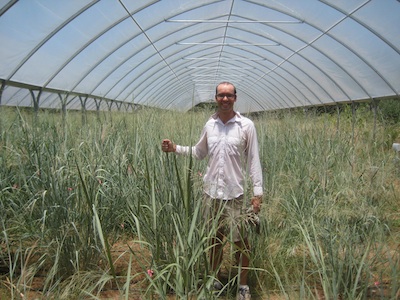 David Lowry, a post-doctoral researcher in the lab of Tom Juenger, stands in one of the lab's experimental switchgrass plots.AUSTIN, Texas — A biologist at The University of Texas at Austin has received a $1.5 million grant from the U.S. Department of Energy (DOE) to study native prairie grasses as potential sources of biofuel.
David Lowry, a post-doctoral researcher in the lab of Tom Juenger, stands in one of the lab's experimental switchgrass plots.AUSTIN, Texas — A biologist at The University of Texas at Austin has received a $1.5 million grant from the U.S. Department of Energy (DOE) to study native prairie grasses as potential sources of biofuel.
The project, which is being led by Tom Juenger, is looking in particular at “panicgrass,” which is native to Texas, Louisiana and New Mexico. The grass is useful as a proxy for studying the genetics and physiology of switchgrass, one of the most likely sources of biofuel in the near future.
“Switchgrass shows enormous potential as a source of biofuels,” said Juenger, associate professor of integrative biology in the College of Natural Sciences. “It’s a beast to study, though. It is a very large perennial plant, requiring a lot of space to grow, and has a very complex genome and breeding system.”
Juenger and his colleagues chose to study Panicum hallii, panicgrass, because although it’s a close genetic relative to switchgrass, it’s much smaller and has a simpler genome.
“We are looking for genes that underlie plant growth, architecture, and response to environmental stresses,” said Juenger. “We will then translate our findings into the more agronomically important switchgrass, Panicum virgatum.”
The grant is part of a larger $41 million investment from the DOE and the U.S. Department of Agriculture in 13 projects that will drive more efficient biofuels production and feedstock improvements.
“If we want to develop affordable alternatives for oil and gasoline that will help reduce our dependence on foreign oil, we need investments like these projects to spur innovation in bioenergy,” said Agriculture Secretary Tom Vilsack. “By producing energy more efficiently and sustainably, we can create rural jobs, boost rural economies and help U.S. farmers, ranchers and foresters prosper.”
In 2009 Juenger and his integrative biology colleagues Christine Hawkes and Tim Keitt received a $4.6 million grant from the National Science Foundation to explore how switchgrass will fare under future climate change.
This grant will further that research and promote investigations of the genes involved in biomass production and tissue quality, both of which are important factors in selecting and breeding potential bioenergy crops. Juenger and his colleagues will be carrying out field components of the research at the College of Natural Sciences' Brackenridge Field Laboratory, the Lady Bird Johnson Wildflower Center, and at the J.J. Pickle Research Campus.
For more information, contact: Daniel Oppenheimer, College of Natural Sciences, 512 745 3353; Tom Juenger, School of Biological Sciences, 512-232-5751, tjuenger@austin.utexas.edu

















Comments 1
i wonder, can 1 man operation ,yield 500 $ net a week ,from biomass cellulosic to ethanol .
what enzymes are best suited for this area mulch ?
permit cost of local municipality ?
pickup or delivery of finished product ?
how many cubic yard of mulched foliage produce a gallon ?
what are optimal operating conditions ?